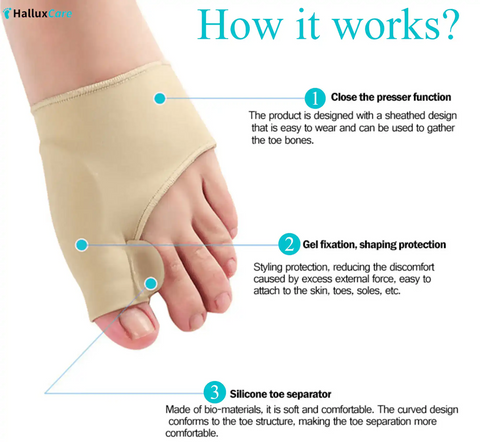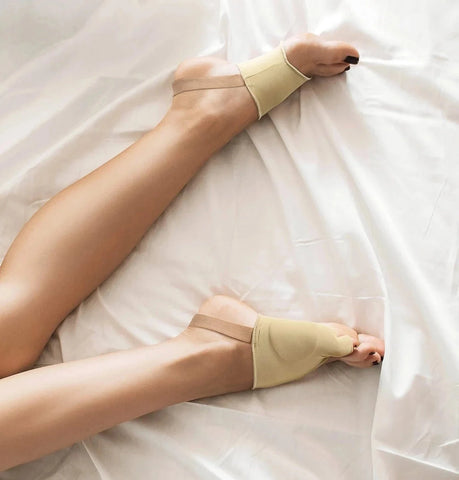Overcoming Bunion Surgery Fears: Strengthening Your Foot and Staying Active
Last updated: 2025-11-24
Author: Dr. Emily Carter, DPM (Doctor of Podiatric Medicine)
Bunions can cause painful discomfort that interferes with daily activities and exercise. The good news is that with proper foot care, targeted exercises, and supportive products, you can manage pain effectively and prepare for surgery if needed, while staying active and hopeful.
Key Takeaways
- Bunions (hallux valgus) and bunionettes (tailor’s bunions) are common foot deformities causing joint pain and swelling.
- Conservative treatments like orthopedic sleeves, proper footwear, and exercises can reduce pain and improve foot function.
- Pre-surgery physical therapy strengthens foot muscles and improves flexibility, promoting faster recovery.
- Choose shoes with a wide toe box and low heels to ease bunion discomfort and prevent worsening.
- Toe spacers and bunion sleeves help realign toes and protect the bunion from friction during daily activities.
- Consult a podiatrist if pain worsens, limits activity, or causes persistent swelling.
What Is a Bunion (Hallux Valgus) and Bunionette (Tailor’s Bunion)?
A bunion, medically known as hallux valgus, is a bony bump that forms at the base of the big toe. This occurs when the big toe leans toward the smaller toes, pushing the joint outward and causing pain, redness, and swelling [1]. A bunionette, or tailor’s bunion, is a similar deformity but affects the base of the little toe, often due to pressure from tight shoes or foot structure [2].
Both conditions can cause discomfort and limit mobility, especially during activities like walking, yoga, or weightlifting.
Symptoms and When to Seek Care
Common symptoms of bunions and bunionettes include:
- Visible bump on the side of the foot near the big or little toe
- Redness, swelling, or inflammation around the joint
- Pain during walking, standing, or wearing shoes
- Limited toe movement or stiffness
- Corns or calluses caused by rubbing shoes
Seek podiatric evaluation if:
- Pain interferes with daily activities or exercise
- Swelling or redness worsens or persists
- Toe deformity progressively increases
- Conservative treatments fail to relieve symptoms [3]
Conservative Management Options and Product Use Guidance
Many people manage bunion pain without surgery by combining foot care products with lifestyle changes.
Orthopedic Bunion Sleeves and Protective Gear
Orthopedic sleeves cushion the bunion, reduce friction, and gently encourage toe alignment. According to the American Orthopaedic Foot & Ankle Society, these sleeves are effective in reducing pain for mild to moderate bunions [4].
4.9 ⭐⭐⭐⭐⭐ ( 1843 reviews )
Tailor’s bunions benefit from specialized protective sleeves that relieve pressure on the outside of the foot:
Footwear Fit and Selection
Proper shoes are a key part of bunion management to reduce pressure and prevent worsening.
- Choose shoes with a wide toe box to provide enough space for toes to move freely [5].
- Opt for soft, breathable materials like leather or mesh to minimize irritation.
- Avoid high heels; keep heel height below 2 inches to reduce forefoot pressure [6].
- Consider adjustable straps or laces for a customized fit.
Exercises and Daily Routines to Support Foot Health
Strengthening and stretching exercises can improve foot mechanics and reduce bunion pain.
Simple Foot Exercises
- Toe stretches: Gently pull the big toe back into alignment using your hands. Hold for 10 seconds, repeat 3 times daily.
- Toe curls: Pick up small objects like marbles with your toes to strengthen muscles.
- Calf stretches: Tight calves can affect foot biomechanics; stretch by leaning against a wall with one leg back.
- Foot arch strengthening: Roll a tennis ball under your foot to massage and strengthen the arch.
How to Use Toe Spacers and Sleeves
- Wear toe spacers during low-impact activities or while resting to gently realign toes.
- Use bunion sleeves under shoes to reduce friction and cushion the bunion during daily wear.
- Start wearing products for 15–30 minutes daily, gradually increasing as tolerated [7].
Preparing for Bunion Surgery: Physical Therapy and Activity Tips
If surgery is recommended, preoperative physical therapy can boost recovery.
- Strengthen foot muscles to improve joint stability.
- Increase flexibility around the bunion to reduce stiffness.
- Maintain low-impact activity like swimming or cycling to preserve fitness.
- Use orthopedic sleeves during exercise for support and pain relief.
After surgery, physical therapy continues to be essential for regaining strength and mobility [8].
Practical Tips for Managing Bunion Pain While Staying Active
- Choose activities that avoid excessive toe pressure (e.g., swimming, cycling).
- Modify weightlifting by using machines or positioning feet to avoid aggravating the bunion.
- Ice your foot after exercise to reduce inflammation.
- Apply moisturizing oils like Jamaica Black Castor Oil to soothe skin and reduce irritation.
- Monitor pain levels and adjust activity intensity accordingly.
Glossary of Key Terms
- Bunion (Hallux Valgus): Deformity of the big toe joint causing the toe to angle toward others.
- Bunionette (Tailor’s Bunion): Similar deformity affecting the little toe side of the foot.
- Toe Spacers: Devices placed between toes to help realign and reduce friction.
- Bunion Sleeves: Soft supports that cushion the bunion and gently correct toe alignment.
- Orthoses: Custom or off-the-shelf shoe inserts designed to support foot structure.
Frequently Asked Questions (FAQs)
Are toe spacers safe for bunions?
Yes, toe spacers are safe when used correctly. They help gently realign toes and reduce pressure. Start with short wear times and increase gradually to avoid discomfort [7].
How long should I wear toe spacers daily?
Begin with 15 to 30 minutes per day and increase as tolerated. Wearing them during rest or low-impact activities is ideal.
Bunion vs tailor’s bunion – what’s the difference?
A bunion affects the big toe joint, while a tailor’s bunion affects the little toe side of the foot. Both cause similar symptoms but in different locations [2].
Do bunion sleeves help with shoe comfort?
Yes, bunion sleeves cushion the bony bump, reducing friction and pain inside shoes, which enhances comfort during wear [4].
When should I see a podiatrist?
Consult a podiatrist if bunion pain worsens, limits your activities, causes persistent swelling, or if conservative treatments don’t relieve symptoms [3].
Can I run or play pickleball with a bunion?
Running or high-impact sports can worsen bunion pain. Low-impact exercises are preferred. If you choose to run or play, use supportive shoes, sleeves, and modify activity intensity [6].
Sources
- MedlinePlus. Bunion. https://medlineplus.gov/ency/article/001225.htm
- American Podiatric Medical Association. Bunionette (Tailor’s Bunion). https://www.apma.org/learn/foot-health/bunions
- National Institute of Health (NIH). When to see a podiatrist for foot pain. https://www.nih.gov/health-information/podiatry
- American Orthopaedic Foot & Ankle Society. Non-surgical treatment of bunions. https://www.aofas.org/footcaremd/treatments/Pages/bunion-treatment.aspx
- Cleveland Clinic. Choosing shoes for bunions. https://my.clevelandclinic.org/health/articles/17487-bunions
- Journal of Foot and Ankle Research. Heel height and foot pressure. https://jfootankleres.biomedcentral.com/articles/10.1186/s13047-019-0360-7
- Cochrane Review. Toe spacers for bunion pain relief. https://www.cochranelibrary.com/cdsr/doi/10.1002/14651858.CD012345.pub2/full
- Journal of Orthopaedic Surgery and Research. Pre- and post-operative physical therapy for bunion surgery. https://josr-online.biomedcentral.com/articles/10.1186/s13018-021-02567-8
Ready to Take Control of Your Bunion Journey?
Managing bunion pain and preparing for surgery can feel overwhelming, but with the right strategies, you can stay active and hopeful. What are your favorite ways to stay strong and pain-free while dealing with bunions? Share your experiences or questions in the comments below—let’s support each other on the path to healthier feet!




